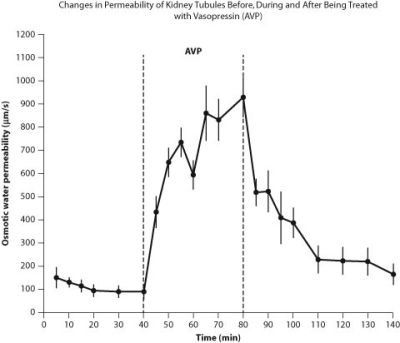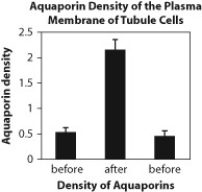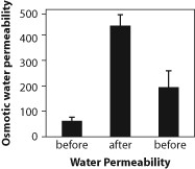Water movement is important in urine formation in the kidneys. Urine is formed when the blood is filtered by the kidneys into kidney tubules. Three figures are presented here that relate to how the kidney tubules respond to the administration of the hormone vasopressin. The direction that water flows in these figures is from the kidney tubules back into the blood.
 Figure A. Changes in permeability of tubules in the kidney in response to the hormone vasopressin (AVP) , which aids in osmoregulation.
Figure A. Changes in permeability of tubules in the kidney in response to the hormone vasopressin (AVP) , which aids in osmoregulation.
 Figure B. Density of aquaporins in kidney tubule cells before, during, and after administration of vasopressin.
Figure B. Density of aquaporins in kidney tubule cells before, during, and after administration of vasopressin.
 Figure C. Permeability of tissues to water before, during, and after administration of vasopressin.
Figure C. Permeability of tissues to water before, during, and after administration of vasopressin.
-How do the data in Figure A relate to the data in Figures B and C?
A) Figure B shows the method used to obtain the data in Figure A.
B) Figure C is essentially a summary of the data in Figure A.
C) Figure A is about water movement, and Figures B and C are about presence of aquaporins.
D) Figure A has data for more than 2 hours, and Figures B and C show data all collected at the same time.
Correct Answer:
Verified
Q56: An energy barrier
A) is the amount of
Q57: Living systems
A) violate the first law of
Q58: The active site of an enzyme is
A)
Q59: Which of the following direct energy transfers
Q60: When a cell uses chemical energy to
Q62: Heating inactivates enzymes by
A) breaking the covalent
Q63: Water movement is important in urine formation
Q64: Americans spend up to $100 billion annually
Q65: Water movement is important in urine formation
Q66: Which part of the ATP molecule breaks
Unlock this Answer For Free Now!
View this answer and more for free by performing one of the following actions

Scan the QR code to install the App and get 2 free unlocks

Unlock quizzes for free by uploading documents